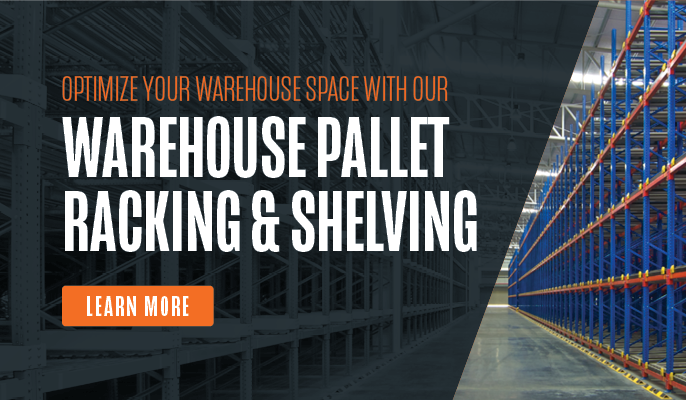How To Decide: Drive-Through Versus Drive-In Racking
by Brian Reaves, on Jan 3, 2025 7:45:00 AM
 You've made the decision to optimize your warehouse's storage space by adopting a high-density storage design. Congratulations! By eliminating unnecessary forklift aisles, you'll increase your storage capacity by an average of 20%. That's a huge gain, but you might wonder how far you can take it.
You've made the decision to optimize your warehouse's storage space by adopting a high-density storage design. Congratulations! By eliminating unnecessary forklift aisles, you'll increase your storage capacity by an average of 20%. That's a huge gain, but you might wonder how far you can take it.
Drive-through and drive-in racking reduce wasted space with unparalleled efficiency. Still, drive-through racking requires one aisle more than drive-in racking. So which one is best? Read on to learn more about the advantages and disadvantages of drive-through and drive-in racking, plus the key differences you need to know when choosing which one is right for your facility.
What Drive-Through and Drive-In Racking Have In Common
Drive-through and drive-in racking are very similar systems. They both feature a high-density storage matrix formed by conventional racking materials. Forklifts drive into the racking to load and unload pallets.
Drive-Through and Drive-In Racking Advantages
Both styles of racking offer distinct benefits over traditional racking configurations.
- Improved storage density. With drive-through and dive-in racking, the forklift drives directly into the racking for loading and unloading. Entering the racking removes the need for aisles between racks. This eliminates wasted space within your warehouse, allowing you to use more of your square footage for storage.
- Reliability. Unlike other kinds of high-density storage, both drive-through and drive-in racking feature no moving parts. They cannot break down and, with quality construction, are failure-resistant. As a result, they are highly dependable styles of racking.
- Cost-effective. There are no special parts or motorized elements with these kinds of racking. They use standard racking components, require no electricity, and little maintenance. Furthermore, they optimize your available storage footprint. All of these benefits make them highly cost-effective storage solutions.
Drive-Through and Drive-In Racking Disadvantages
As with all storage solutions, these racking styles have a few drawbacks.
- Reduced selectivity. In a dense pallet matrix like the kind used in drive-through and drive-in racking, not all pallets are immediately accessible. Operators must move pallets on the outsides before accessing middle pallets. This reduces the selectivity of this kind of storage solution compared to traditional racking, making drive-through and drive-in racking best when storing a limited number of SKUs.
- Increased damage potential. To load or unload the interior of the racking matrix, the forklift operator must drive the forklift into the racking, creating a very narrow working environment. This increases the likelihood that a forklift will collide with the rack and potentially damage it. A collision can severely damage the rack’s structural integrity, increasing the risk of a collapse.
- Honeycombing potential. Rushed operators sometimes cut corners. For example, a dead space occurs when an operator fails to load pallets at the back of the available racking. This is called honeycombing, and drive-through and drive-in racking are more susceptible to it because each rack is several pallets deep. The risk of honeycombing can be reduced through proper forklift operator training.
The Key Difference Between Drive-Through and Drive-In Racking
So far, we've discussed everything drive-through and drive-in racking have in common. However, there is one crucial distinction between the two that is often the deciding factor when choosing one over the other.
Last-In, First-Out
Of the two, drive-in racking is slightly more space-efficient than drive-through racking since it only requires one aisle. Its racking matrix can sit against a wall without a rear aisle. However, because the matrix is only accessible from one side, operators must load back to front and then unload front to back. This mandates a last-in, first-out loading procedure best suited for shelf-stable materials and materials with distant expiration dates.
First-In, First-Out
Drive-through racking requires two forklift-accessible aisles: one at the front of the racking matrix for loading and one at the rear for unloading. Consequently, it is less space-efficient than drive-in racking. However, the two aisles allow for a first-in, first-out loading paradigm. This makes drive-through racking best suited for SKUs with short-term expiration dates, like food and beverages.
Dynamic Pallet Racking Solutions
By now, you know how to choose between drive-through and drive-in racking, but what if you’ve realized that your facility needs both? You’re not alone. In fact, most warehouses benefit from a combination of storage solutions. That’s where we come in.
Our solutions team has the expertise you need to figure out what ratio of storage solutions best fits your operational needs now and in the future. We’ll help you choose the most efficient and affordable solutions and have them professionally installed in your facility. To learn more about warehouse storage solutions, contact us online or visit one of our locations throughout Georgia and Florida.
Florida
Jacksonville
Lakeland
Ocala
Orlando
Tampa
Winter Haven
Georgia
Albany
Macon
Columbus
Valdosta
Drive In Racks vs Shuttle Pallet Racking: Which Is Best for You?
Is It Better To Repair Or Replace Pallet Racking?
Is It Okay To Mix Racking Materials From Different Manufacturers?








